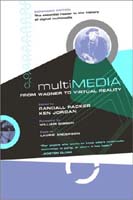
click
to purchase |
|
Expanded Paperback Edition
Edited by Randall Packer and Ken Jordan
Foreword by William Gibson
Coda by Laurie Anderson
W.W. Norton, New York (2002)
ISBN: 0-393-32375-7
|
|
| About
the Book |
This
Website is the interactive companion to the book of the
same title,
Multimedia: From Wagner to Virtual Reality.
A unique collection of seminal essays, the print edition
traces a fertile series of collaborations between the
arts and the sciences, going back to the years just after
World War II and even further, to composer Richard
Wagner, whose ideas about the immersive nature of music
theater foreshadowed the experience of virtual reality.
Among
the essential articles gathered here are the Futurists'
1916 manifesto on cinema, which declared that the new
medium would unite all media and replace the book; Vannevar
Bush's 1945 Atlantic Monthly essay that leads directly
to the hyperlinks in today's multimedia; J.C.R. Licklider's
groundbreaking idea in 1960 that people and computers
could collaborate in creative work; Nam June Paik's 1984
essay proposing that satellite technology would encourage
a global information art; Tim Berners-Lee's 1989 proposal
for a document-sharing network, which became the basis
of the World Wide Web; and William Gibson's discussion
of how he came up with the word "cyberspace."
With an insightful introduction to the volume and critical
commentaries on each article, editors Randall Packer and
Ken Jordan lead us through the groundbreaking developments
of the multimedia story.
Excerpt from the foreword by William Gibson:
"Multimedia, in my view, is not an
invention but an ongoing discovery of how the mind and
the universes it imagines (or vice versa, depending) fit
together and interact. Multimedia is where we have always
been going. Geeks and artboys, emerging together from
the caves of Altamira, have long been about this great
work. This book is one start toward a different sort of
history, a history cognizant of an impulse that seems
to me always to have been with us."
"I recommend this book to you with
an earnestness that I have seldom felt for any collection
of historic texts. This is, in large part, where the bodies
(or, rather, the bones of the ancestors) are buried. Assembled
this way, in such provocative proximity, these visions
give off strange sparks. Think of it, if you like, as
a cut-up in Burroughss best sense, an interleaving
of histories intended to open intertextual doors, some
of which, given the right reader, have never before been
opened. Perhaps you are that reader."
"If not, keep it handy: you may be
that reader one day, be you geek or artboy (of either
gender, please) or (more likely) some evolved hybrid of
the two."
"Someone, it seems, always has to be."
|
| |
|
|
Table
of Contents
|
Foreword by William Gibson
Coda by Laurie Anderson
Overture by Randall Packer and Ken
Jordan
I. Integration
1. Richard Wagner, "Outlines
of the Artwork of the Future"
2. F. T. Marinetti,
Bruno Corra, Emilio Settimelli, Arnaldo Ginna, Giacomo
Balla, Remo Chiti, The Futurist Cinema
3. László Moholy-Nagy, Theater,
Circus, Variety
4. Richard Higgins, Intermedia
5. Billy Klüver, The Great Northeastern
Power Failure
6. Nam June Paik, Cybernated Art and Art
and Satellite |
II. Interactivity
7. Norbert Wiener, Cybernetics
in History
8. J.C.R. Licklider, Man-Computer Symbiosis
9. Douglas Engelbart, Augmenting Human Intellect:
A Conceptual Framework
10. John Cage, Diary: Audience 1966
11. Roy Ascott, Behaviourist Art and the Cybernetic
Vision
12. Myron Krueger, Responsive Environments
13. Alan Kay, User Interface: A Personal View
14. Jeffrey Shaw, "Modalities of Interactivity
and Virtuality" |
III. Hypermedia
15. Vannevar Bush, As We May
Think
16. Ted Nelson, excerpt from Computer Lib/Dream
Machines
17. Alan Kay and Adele Goldberg, Personal
Dynamic Media
18. Richard A. Bolt, "Spatial Data-Management"
19. Marc Canter, The New Workstation: CD ROM
Authoring Systems
20. Tim Berners-Lee, Information Management:
A Proposal
21. George Landow and Paul Delany, Hypertext,
Hypermedia and Literary Studies: The State of the
Art |
IV. Immersion
22. Morton Heilig, The Cinema
of the Future
23. Ivan Sutherland, The Ultimate Display
24. Scott Fisher, Virtual Interface Environments
25. William Gibson, Academy Leader
26. Marcos Novak, Liquid Architectures in
Cyberspace
27. Daniel Sandin, Thomas DeFanti, and Carolina
Cruz-Neira, A Room with a View
28. Char Davies, "Changing Space: Virtual
Reality as an Arena of Embodied Being" |
V. Narrativity
29. William Burroughs, The
Future of the Novel
30. Allan Kaprow, Untitled Guidelines for
Happenings
31. Bill Viola, Will There Be Condominiums
in Data Space?
32. Lynn Hershman, The Fantasy Beyond Control
33. Roy Ascott, Is There Love in the Telematic
Embrace?"
34. Kit Galloway and Sherrie Rabinowitz, "Welcome
to 'Electronic Café International': A Nice
Place for Hot Coffee, Iced Tea, & Virtual Space"
35. Pavel Curtis, Mudding: Social Phenomena
in Text-Based Virtual Realities
36. Pierre Lévy, The Art and Architecture
of Cyberspace
37. Janet Murray, "Agency" |
|
| |
|
| |
|
| |
|
| |
Legal
Information © 2000 Artmuseum.net |
|
|